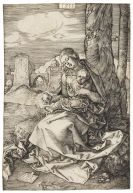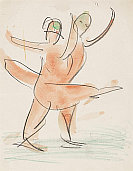
Cherubino Alberti
1553 Sansepolcro
1615 Rom
Cherubino (Zaccaria Mattia) Alberti, born on February 24, 1553 in the Tuscan town of Sansepolcro, was an Italian painter and copperplate engraver who also worked as a military engineer.
After the son of an artist family learned the art of painting and fresco painting from his father Michele, Alberti first turned to copperplate engraving – initially etching and later with the chisel. His style was influenced by Agostino Carracci and, above all, by Cornelis Cort, who presumably taught both Alberti and Carracci in Rome. Most of his more than 200 known copperplate engravings were created between 1568 and 1612 following such examples as Michelangelo and Raffael, but some were also based on his own motifs.
The latter were primarily reproductions of ancient sculptures, as well as scenes from the Old and New Testaments and mythological and allegoric depictions. Alberti often signed with the abbreviation CAB (Cherubinus Albertus Burgensis). His works are distinguished by their precision and elegance, exhibiting fine nuances of light and dark.
In the 1580s, Alberti once again shifted his focus to fresco painting. His early works, which were often collaborations with his father and two brothers Alessandro and Giovanni, are now either partially unknown or can only be verified on the basis of contracts. The best-known are his vault and wall frescoes of the Sala Clementina in the Vatican, which he completed in 1598 after working on them for three years with his brother Giovanni. Their themes are the Storie della vita di S. Clemente I Papa. During the execution of these frescoes, Alberti was sentenced to death in absentia in 1598 on a murder charge. However, he received a writ of protection from the Pope for a period of six months so that he could continue his work. He was later granted complete immunity. At the end of his life, Alberti dedicated himself to the construction of military equipment and appears to no longer have been artistically active.
From 1611 to 1614, Alberti was the head of the Accademia di San Luca in Rome, an association of artists that he actively helped found in 1593.
Cherubino Alberti died, apparently as a result of a severe illness, on October 18, 1615 in Rome. He was buried in the family grave at Chiesa di Santa Maria del Popolo in Rome.
Even during his lifetime, Alberti was accepted into the Nobili Romani by the pope and distinguished with the title of a Knight of the Lily and the Golden Spur. He also received the right to include the golden grid from Pope Aldobrandini’s coat of arms in his own family coat of arms.

Would you like to sell a work by Cherubino Alberti?
Infos for seller






